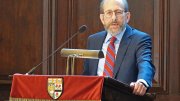Harvard College announced today that 2,032 applicants had been offered admission to the class of 2016, entering this August—5.9 percent of 34,302 applicants.
The admissions rate last year was 6.2 percent (2,158 offers of admission extended to 34,950 applicants).
It may seem paradoxical that fewer applicants were offered admission, pushing the acceptance rate down, in a year when the total pool of would-be Harvardians decreased by about 2 percent. But that reflects the reinstatement of early-action admissions, which attracted more than 4,200 applications by the deadline last November, and the decision, announced last December, to admit 772 of those candidates—the equivalent of nearly half an entering class. Admissions officers expect the “yield” (student acceptance of Harvard’s offer of admission) to be higher for the early-action pool than for candidates filing under the regular deadline; to ensure that enrollment does not exceed the College’s capacity, they had to reduce the admission rate for the rest of the pool (although not as drastically as the Crimson estimated earlier this week).
The College’s news release cited the challenges this posed:
With the return of early action this year, it is more difficult than in the past to predict how many admitted students will accept Harvard’s offer of admission. “We have always been conservative about the number of acceptances sent out at this time of year in order to avoid the possibility of overcrowding. Harvard’s high graduation rate—typically 97 to 98 percent—leaves little margin for error,” said William R. Fitzsimmons, dean of admissions and financial aid. “As always, we expect to use the waiting list….”
All admitted students have until May 1 to indicate their acceptance or rejection of Harvard’s offer of admission; the “Visitas” visiting period for those accepted applicants who wish to kick the tires in Cambridge falls on the weekend of April 21 to 23.
Yale admitted 6.8 percent of applicants (1,975 of 28,974); the Yale Daily News published a useful chart showing many peer schools' admission rates. Princeton admitted 7.9 percent of applicants (2,095 of 26,664). Stanford admitted 6.6 percent of applicants (2,427 of 36,631). Among the leading, selective research universities reporting, all almost all set a record low for their rate of admissions this year.
Reflecting wide interest in elite institutions' admissions decisions, "The Choice," a New York Times blog on admisssions and financial aid, is inviting applicants to post comments as they receive e-mail notifications today.








